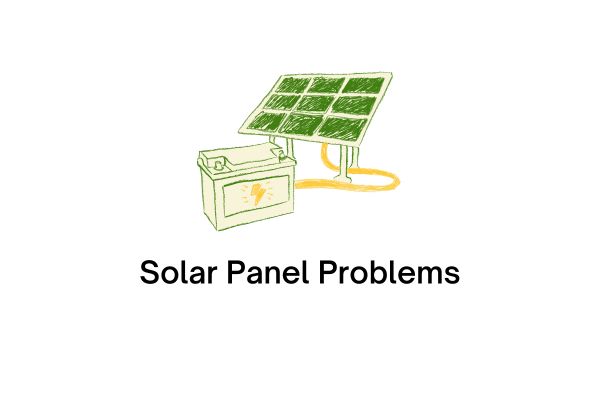Solar panels are made of semi-conductor materials with an outer layer of glass so they are prone to damage if not treated properly. The following are solar panel problems that might be happen:
Daftar Isi
1. Broken or Cracked Solar Panels
Solar panels use glass as the top layer which functions to protect the photovoltaic cells underneath. Glass is also strong, does not absorb water, is an insulator and is transparent so that it does not interfere with the working system of the solar panel.
The surface of the solar panel must be ensured to be free of cracks so that the solar panel can work optimally to produce electrical energy. The amount of solar panel output depends on the amount of irradiation that can be absorbed by the solar cells. If the surface of the solar panel is broken, its absorption capacity will be reduced so that the power produced is not optimal.
The causes of broken solar panels are:
- a. Scratched by sharp objects
- b. Hit by a fallen tree
- c. Rising temperatures resulting in hotspots
- d. Hit by other objects
- e. Poor support structure
It is not recommended that broken solar panels be connected to other solar panels. Because oxygen and water can enter until moisture occurs, causing corrosion of cables and short circuits.
There are several solutions to prevent solar panels from cracking, namely:
- 1) When cleaning maintenance, make sure not to apply too much pressure
- 2) Do not step on the sides of the solar panels
- 3) Avoid installing solar panels near trees
- 4) Ensure safety during packaging and placement of solar panels during the shipping process
- 5) Store solar panels with good packaging
- 6) Routine checks on all installed solar panels to see if there is any possible damage
- 7) Immediately replace the solar panel with the same type if the crack is mostly on the surface of the solar panel
2. Hot spot
A hot spot is a hot spot that occurs because part of the solar panel area is shadowed and becomes a burden because it produces low energy compared to other parts. The shadow effect is the possibility of blocking the solar panel due to the shadow of an object, resulting in reduced sunlight irradiation that can be received by the cells on the solar panel.
Shadows are often caused by:
- 1) Clouds passing by
- 2) Tall buildings
- 3) Tall towers
- 4) Trees
- 5) Bird droppings
- 6) Dust
- 7) Shadows from one panel to the other
Solar panels have bypass diodes embedded in them to reduce the detrimental effects of shading. In reality, shading cannot be completely prevented, especially during sunrise or sunset when shadows become long. Because the system’s energy production is less in the morning and evening, a little shading is generally acceptable. Therefore, the installation of solar panels must be free from the effects of shadows around. Such as paying attention to the most efficient place to install solar panels so that they can avoid the effects of shadows.
3. Solar Panels Burn
Solar panels are designed to produce electric current when sunlight shines on the solar panels. When current flows through the string of solar cells inside the solar panel, the resistance in the cells converts the current into heat.
The causes of solar panels burning are:
- 1) Due to production errors such as design defects or cracks
- 2) Poor solder joints, and incompatibility,
- 3) Design and installation errors
- 4) Old components and worn connectors
- 5) Natural factors
4. Microcracks on Solar Panels
Advances in semiconductor processing have produced ultra-thin solar cells, meaning they are very fragile and easily broken when subjected to strong shocks. Microcracks on solar modules are microscopic cracks that are barely visible on solar cells. When microcracks form on solar panels, damaged solar cells have difficulty conducting electricity, resulting in low power output and hot spots.
To avoid microcracks, checks must be carried out on the panels and ensure whether there are errors during production, in addition, when transporting solar panels, care must be taken to avoid impacts to the solar panels.
5. Defective Junction Box
A junction box is a small box located on the back of the solar panel, which functions as a protector for the solar panel output cable connection to channel electricity outward. If water or dust seeps into the junction box cover, the bypass diode inside can short out and burn out. A burned diode or connector can cause the solar panel to go into an open circuit and stop transferring energy to the outside at all. A solar panel in this condition must be replaced with the same type of solar panel.
6. Snail Track
Snail track is a sign that resembles a snail’s path on the surface of solar cells on solar panels. In the long term, snail tracks cause microcracks in solar cells and form hotspots in several places.
Snail Track can occur when we install solar panels too close to the roof, especially on roofs that use lightweight steel, which can cause heat on the roof to spread to the flowing solar panels, the heated panels also become hot due to light reflection then the panels will overheat and eventually snail tracks will appear.
Therefore, it is better not to install solar panels too close to the roof or leave a distance of about 30-50cm from the roof, aiming for air circulation so that the PV does not overheat and trigger the appearance of snail tracks.
Read Also:
